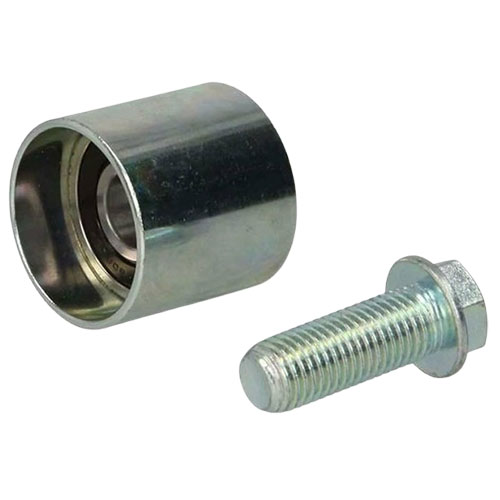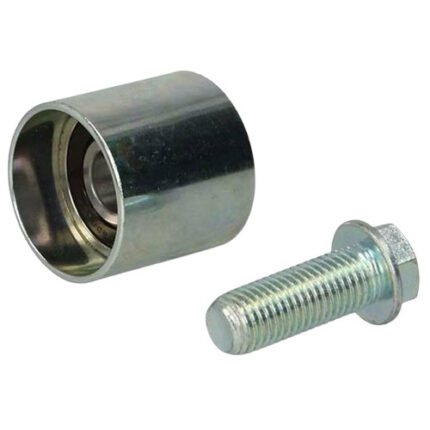Get AUDI A3 8P Timing Belt Idler Roller – Lower 06B109244 in Kenya
The timing belt idler roller is an essential component of a vehicle’s timing belt system. It plays a critical role in ensuring the proper operation of the timing belt, which is crucial for maintaining engine timing and overall performance. Here’s a comprehensive yet straightforward explanation of what it is, how it works, and why it’s important.
What is a Timing Belt Idler Roller?
The timing belt idler roller is a wheel or pulley that helps guide and tension the timing belt in an engine. The timing belt is responsible for synchronizing the rotation of the crankshaft and camshaft(s), ensuring that the engine’s valves open and close at the correct times during the combustion cycle. The idler roller is a component within this system that aids in maintaining the correct tension and alignment of the timing belt.
How Does the Timing Belt Idler Roller Work?
Here’s how the timing belt idler roller functions:
- Supporting the Timing Belt: The idler roller helps to support and guide the timing belt as it moves around the pulleys and gears in the engine. By providing a smooth surface for the belt to travel on, the roller helps prevent slippage and ensures accurate timing.
- Maintaining Tension: The idler roller helps maintain the correct tension of the timing belt. Proper tension is crucial for the belt to function effectively and to prevent it from becoming too loose or too tight. The idler roller is often adjustable to allow for fine-tuning of the belt tension.
- Reducing Wear and Tear: By providing a smooth, low-friction surface for the timing belt, the idler roller helps reduce wear and tear on the belt. This contributes to the longevity and reliability of the timing belt system.
- Preventing Misalignment: The idler roller ensures that the timing belt remains properly aligned with the camshaft and crankshaft pulleys. Proper alignment is essential for maintaining accurate engine timing and preventing damage to the belt or other engine components.
Why is the Timing Belt Idler Roller Important?
The timing belt idler roller is crucial for several reasons:
- Ensures Proper Timing: The timing belt idler roller helps ensure that the timing belt maintains the correct tension and alignment. This is essential for proper engine timing, which affects engine performance, fuel efficiency, and overall reliability.
- Prevents Engine Damage: A properly functioning idler roller helps prevent issues such as belt slippage, misalignment, or excessive wear. These issues can lead to engine damage, including valve-to-piston contact, which can be costly to repair.
- Extends Timing Belt Life: By reducing friction and maintaining proper tension, the idler roller helps extend the life of the timing belt. This reduces the frequency of belt replacements and helps avoid unexpected breakdowns.
- Supports Engine Performance: Accurate timing and proper belt tension are essential for optimal engine performance. The idler roller contributes to smooth engine operation, efficient power delivery, and reliable performance.
Signs of a Failing Timing Belt Idler Roller
A failing timing belt idler roller can lead to various issues. Here are some common signs that the idler roller may be failing:
- Unusual Noise: A worn or damaged idler roller may produce unusual noises, such as squealing, grinding, or rattling sounds. These noises can indicate that the roller bearings are failing or that the roller is not functioning properly.
- Timing Belt Slippage: If the idler roller is not maintaining proper tension or alignment, the timing belt may slip or jump teeth. This can cause erratic engine performance, loss of power, or difficulty starting the engine.
- Engine Misalignment: A failing idler roller can lead to misalignment of the timing belt, which can affect engine timing. This may result in poor engine performance, rough idling, or increased fuel consumption.
- Visible Damage: Inspecting the idler roller may reveal visible signs of damage, such as cracks, corrosion, or excessive wear. These issues can affect the roller’s ability to support and guide the timing belt effectively.
- Vibration: Excessive vibration or shaking from the engine may indicate a problem with the idler roller. This can occur if the roller is not properly aligned or if the bearings are worn out.
Maintaining the Timing Belt Idler Roller
Proper maintenance of the timing belt idler roller involves several key practices:
- Regular Inspections: Periodically check the timing belt idler roller for signs of wear, damage, or misalignment. Regular inspections can help identify potential issues before they lead to more significant problems.
- Follow Manufacturer’s Recommendations: Adhere to the vehicle manufacturer’s recommended maintenance schedule for the timing belt and associated components, including the idler roller. This helps ensure that the roller and belt are replaced at the appropriate intervals.
- Check Tension and Alignment: Regularly check the tension and alignment of the timing belt. Proper tension and alignment are essential for the idler roller to function effectively and to prevent issues with the belt.
- Replace Worn Components: If the idler roller shows signs of significant wear or damage, replace it promptly. This helps prevent further issues with the timing belt system and ensures reliable engine performance.
Replacing the Timing Belt Idler Roller
If the timing belt idler roller fails or shows signs of significant wear, it’s important to replace it. Here’s a general guide to the replacement process:
- Preparation: Gather the necessary tools, a new idler roller, and any other required parts. Ensure the engine is cool and secure the vehicle on a flat surface.
- Remove the Timing Belt: To access the idler roller, you’ll need to remove the timing belt. This typically involves loosening or removing the timing belt tensioner and any covers or components obstructing access to the belt.
- Remove the Old Idler Roller: Unbolt or remove the old idler roller from its mounting position. Be prepared for some debris or coolant to spill during this process.
- Install the New Idler Roller: Position the new idler roller in place and secure it with bolts or fasteners. Ensure it is properly aligned and tightened according to the manufacturer’s specifications.
- Reinstall the Timing Belt: Reinstall the timing belt, ensuring it is properly aligned with the camshaft and crankshaft pulleys. Adjust the tension as needed according to the manufacturer’s recommendations.
- Reassemble the Engine: Reinstall any components or covers that were removed to access the idler roller and timing belt. Ensure everything is properly secured and reconnected.
- Check for Proper Operation: Start the engine and check for any signs of noise, vibration, or misalignment. Ensure the timing belt operates smoothly and that the idler roller is functioning correctly.
Follow us on Facebook for more parts.




